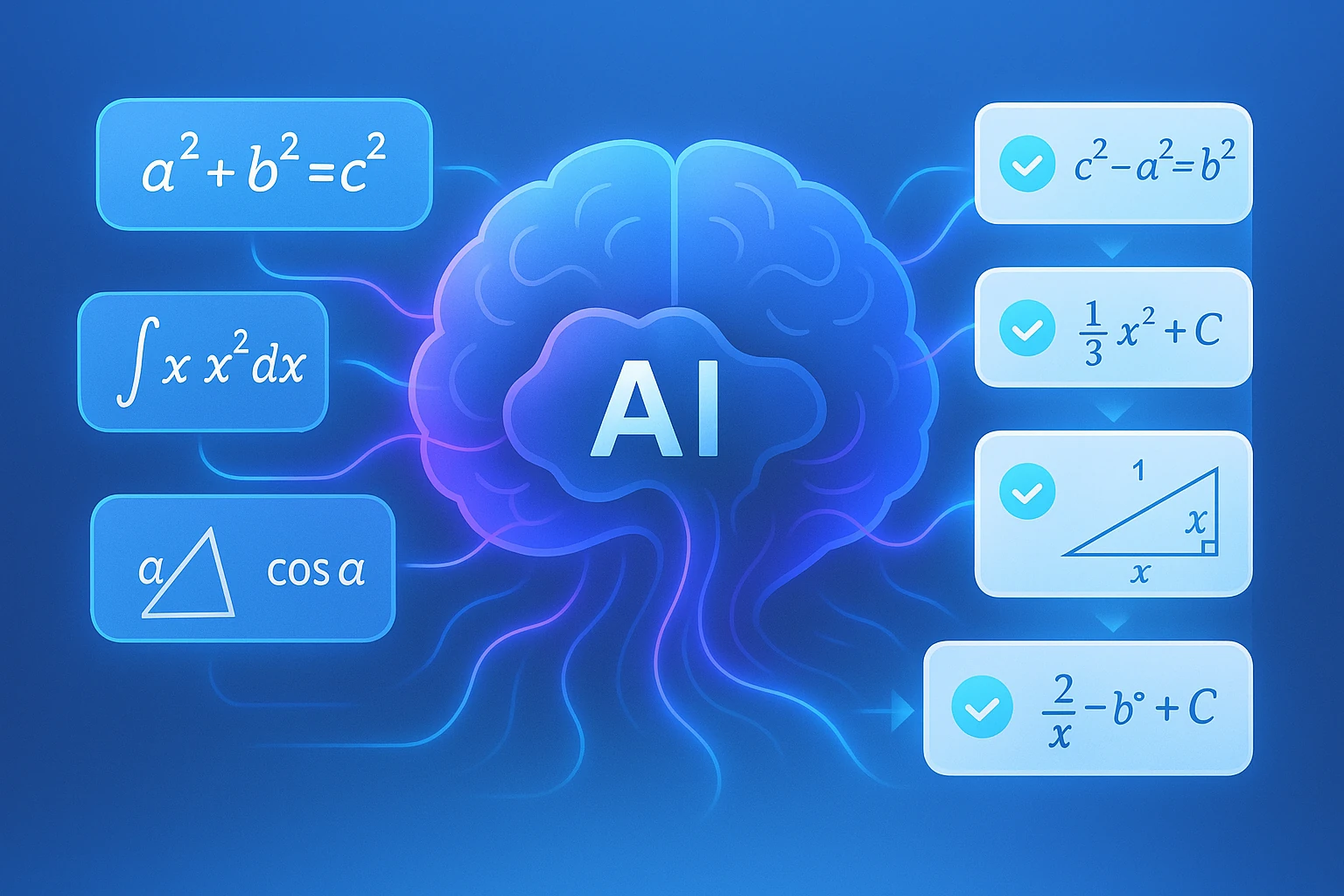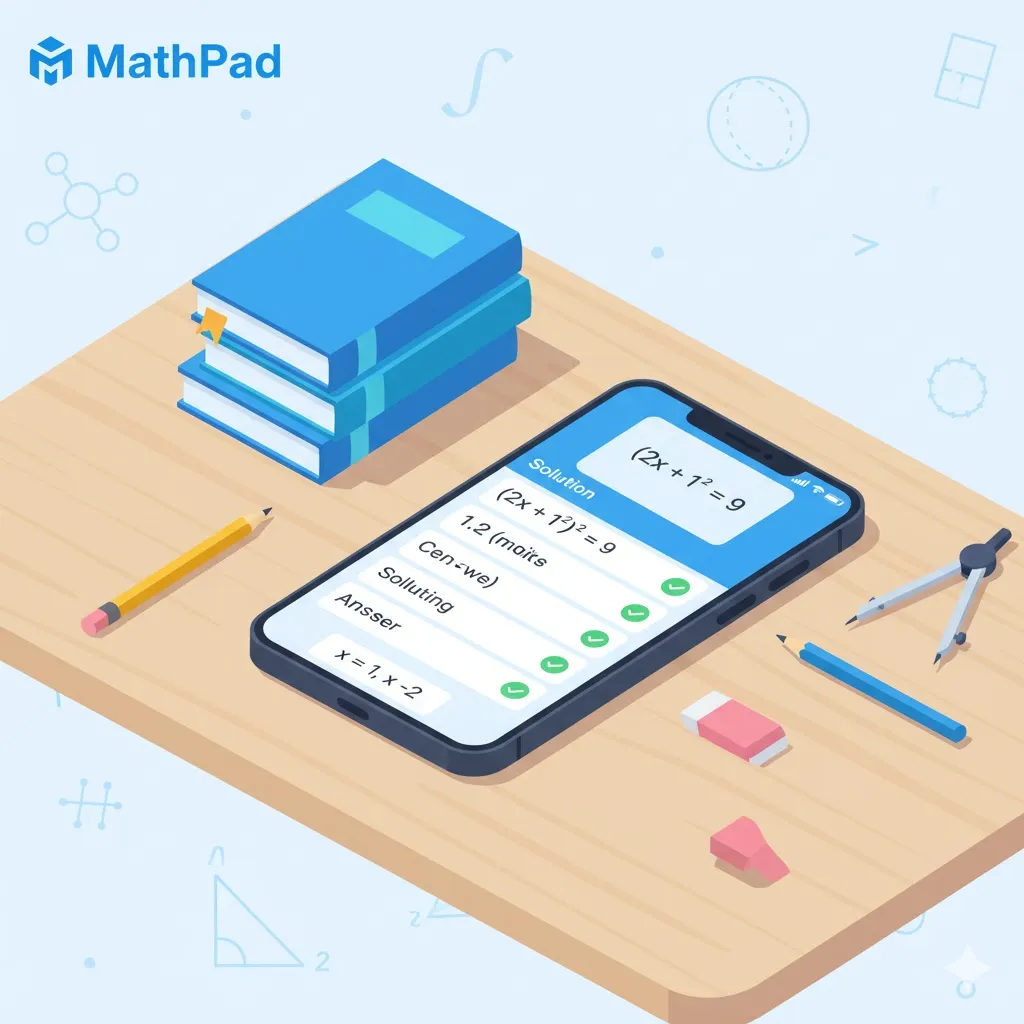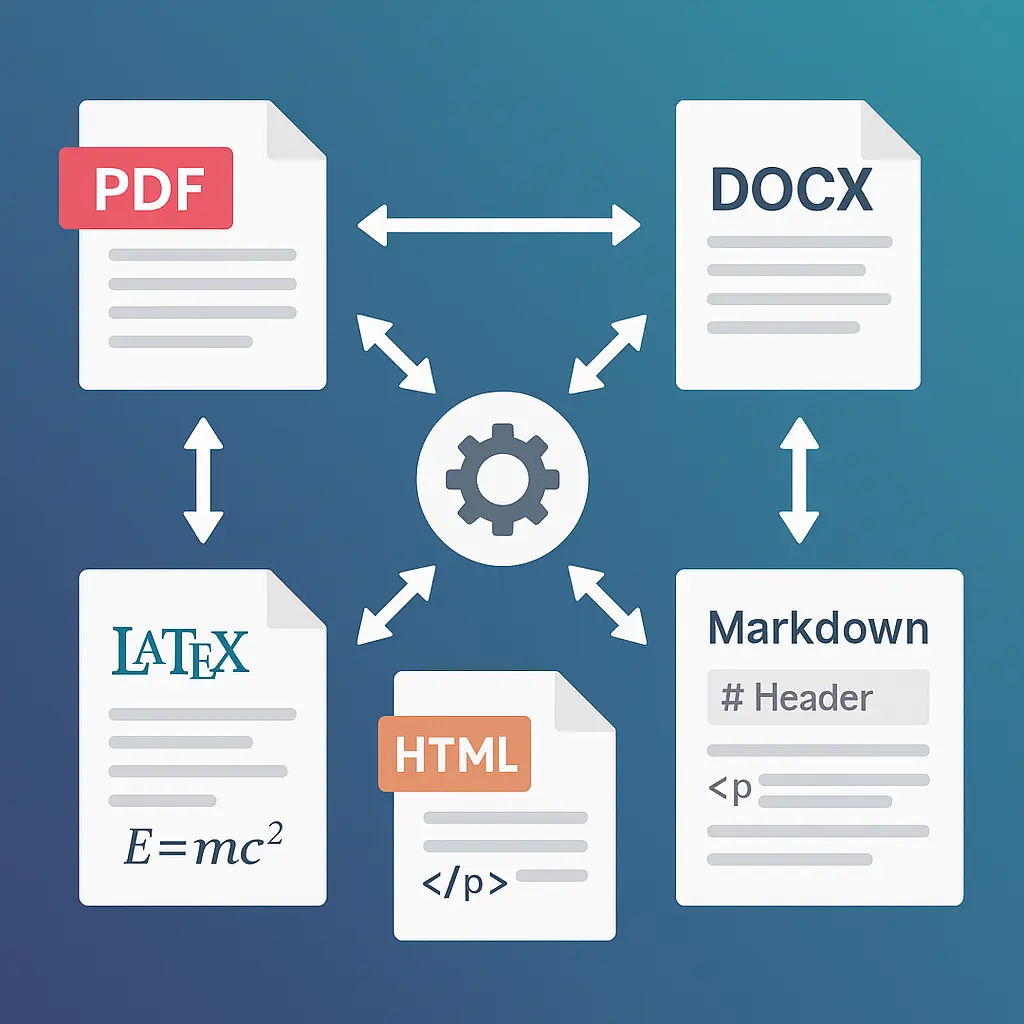If you've ever stared at a math problem for 20 minutes wondering where to even start, you're not alone. Math homework can be frustrating, especially when you're stuck and your teacher isn't available. That's where AI math solvers come in—and they're changing how students learn math.
But here's the thing: not all AI math tools are created equal. Some just spit out answers (useless for learning). The good ones actually teach you how to solve problems yourself.
What Makes a Good AI Math Solver?
A proper AI math solver does four things:
1. Recognizes your problem instantly
Take a photo of any math problem—handwritten homework, textbook questions, even messy whiteboard work. Good OCR technology converts it to digital format in 2-3 seconds.
2. Shows its work (this is crucial)
Anyone can give you an answer. A learning tool shows every single step of the solution, so you understand the process.
3. Explains like a real tutor
When you're confused about step 3, you can ask "why did you do this?" and get a clear explanation—not a Wikipedia article.
4. Covers all math levels
From basic algebra to multivariable calculus, differential equations, linear algebra, statistics—it should handle whatever your course throws at you.
💡 Pro tip: The best way to use these tools is to try the problem yourself first, then use the AI to check your work and understand where you went wrong. Copying answers won't help you pass the test.
📸 Ready to get unstuck? Try MathPad Free →
How It Actually Works (The Tech Behind the Magic)
Here's what happens in those 2-3 seconds after you snap a photo:
Step 1: Computer Vision Reads Your Handwriting
The AI uses OCR trained on millions of math problems. It can read:
- Messy handwriting (yes, even yours)
- Printed textbook problems
- Whiteboard photos taken at an angle
- Even problems with crossed-out work
It converts everything to LaTeX—the standard format for mathematical notation. So $x^2 - 5x + 6 = 0$ might look different on paper, but the AI sees the same structured equation every time.
Step 2: Problem Classification
The AI figures out what kind of problem it's dealing with:
- Is this algebra or calculus?
- Linear equation or quadratic?
- Do we need derivatives, integrals, or just simplification?
This step is crucial because different problem types need different solution strategies. A derivative uses power rules and chain rules. A system of equations might need substitution or elimination.
Step 3: Symbolic Math Engine (CAS)
Here's where the real work happens. The AI doesn't just plug numbers into a calculator—it manipulates symbols algebraically, just like you would by hand.
Example: Solving $x^2 - 5x + 6 = 0$
The AI recognizes this is a quadratic and applies the quadratic formula:
$$x = \frac{-b \pm \sqrt{b^2-4ac}}{2a}$$
With $a = 1$, $b = -5$, $c = 6$:
$$x = \frac{5 \pm \sqrt{25-24}}{2} = \frac{5 \pm 1}{2}$$
Solutions: $x = 3$ or $x = 2$
But here's what makes it a learning tool: it shows you why each step works, not just what the next step is.
Step 4: Natural Language Explanations
This is where AI really shines. You can ask:
- "Why can't I just divide by $x$ here?"
- "Is there another way to solve this?"
- "What does this step even mean?"
The AI explains in plain English, adjusts to your level, and gives you practice problems when you're ready.
Features That Actually Matter
Here's what separates a useful learning tool from a glorified calculator:
1. Photo Recognition (SnapSolve)
Snap a photo, get a solution. Works with handwritten homework, textbook problems, even whiteboard photos. Way faster than typing out complex equations.
The catch: Some tools struggle with messy handwriting or unusual notation. Good ones handle it 95%+ of the time.
2. Step-by-Step Explanations
This is non-negotiable. You need to see the work.
Bad example: "The answer is $x = 3$"
Good example: Shows you how to factor, why you set each factor to zero, and where both solutions come from.
For $\int x^2 , dx$:
- Apply power rule: $\int x^n , dx = \frac{x^{n+1}}{n+1} + C$
- With $n = 2$: $\frac{x^{2+1}}{2+1} + C$
- Simplify: $\frac{x^3}{3} + C$
3. Interactive Q&A
Can you ask follow-up questions? This is huge for actual learning.
Example:
You: "Why do we add + C in integration?"
AI: "When you take a derivative, any constant becomes zero. So when you integrate (reverse the process), there could have been any constant originally. We write + C to represent all possibilities."
That's the kind of explanation that actually clicks.
4. Solution Checker
Write your own solution, photograph it, and the AI checks your work. This is perfect for:
- Verifying homework before you submit
- Understanding where your logic went wrong
- Building confidence in your problem-solving
5. Multiple Math Subjects
A good tool covers:
- Algebra (equations, polynomials, factoring)
- Calculus (derivatives, integrals, limits)
- Trigonometry (identities, graphs, applications)
- Statistics (probability, distributions)
- Linear algebra (matrices, systems)
- Geometry (proofs, area/volume calculations)
6. Practice Problem Generator
After you solve one problem, the AI can generate 5-10 more just like it. Different numbers, same concept. That's how you actually learn—repetition with variation.
AI Math Solver vs. Traditional Tools
| Feature | AI Math Solver | Traditional Calculator | Human Tutor |
|---|---|---|---|
| Photo recognition | ✅ Yes | ❌ No | ❌ No |
| Step-by-step explanations | ✅ Yes | ❌ No | ✅ Yes |
| 24/7 availability | ✅ Yes | ✅ Yes | ❌ No |
| Cost | Free/$15/mo | Free | $30-60/hour |
| Instant answers | ✅ Yes | ✅ Yes | ❌ No |
| Interactive Q&A | ✅ Yes | ❌ No | ✅ Yes |
| All subjects | ✅ Yes | ⚠️ Limited | ⚠️ Depends |
| Personalized learning | ✅ Yes | ❌ No | ✅ Yes |
Verdict: AI math solvers combine the speed of calculators with the teaching ability of tutors—at a fraction of the cost.
How to Use an AI Math Solver Effectively
To get the most value from AI math tools, follow these best practices:
✅ DO: Use it as a Learning Tool
- Try the problem yourself first (for 5-10 minutes)
- Use the AI to check your work and identify mistakes
- Study the step-by-step solution to understand the method
- Ask follow-up questions on confusing steps
- Practice similar problems to reinforce learning
❌ DON'T: Use it as a Copy Machine
- Blindly copying answers defeats the purpose of homework
- You won't learn the concepts for exams
- Teachers can often detect AI-generated work
The goal: Use AI to understand problems, not just complete assignments.
Real Student Success Stories
Case Study 1: Calculus Breakthrough
Student: Sarah, 11th grade Challenge: Struggling with integration techniques Solution: Used MathPad's SnapSolve to:
- Photograph 20 practice integration problems
- Study step-by-step solutions for each method (substitution, parts, partial fractions)
- Ask AI Tutor clarifying questions
- Generate 10 more practice problems per technique
Result: Grade improved from C to A- in 3 weeks.
Case Study 2: Homework Efficiency
Student: Mike, college engineering major Challenge: Spending 4+ hours on math homework Solution: Used Step Checker to:
- Solve problems independently
- Verify answers instantly
- Fix errors immediately instead of waiting for TA feedback
Result: Homework time reduced to 2 hours while maintaining accuracy.
Choosing the Best AI Math Solver
When evaluating AI math tools, consider these factors:
🎯 1. Accuracy & Reliability
- Does it handle complex notation correctly?
- Are step-by-step solutions mathematically sound?
- Can it explain why a solution is correct?
📱 2. User Experience
- Is the photo capture fast and accurate?
- Is the interface intuitive?
- Does it work on mobile and desktop?
💰 3. Pricing & Value
- Free tier available?
- Cost vs. private tutoring?
- Unlimited usage or restricted?
📚 4. Subject Coverage
- Does it cover all your math subjects?
- Handles high school and college-level problems?
- Specialized features (graphing, 3D geometry, proofs)?
🤖 5. AI Quality
- Can it answer follow-up questions intelligently?
- Does it adapt explanations to your level?
- Natural language interaction quality?
Why MathPad is the Best AI Math Solver for Students
MathPad combines all the essential features into one comprehensive platform:
🚀 Core Features
- SnapSolve: Industry-leading OCR for handwritten and printed math
- AI Tutor: Interactive explanations with unlimited follow-up questions
- Step Checker: Verify your own solutions step-by-step
- Problem Generator: Unlimited practice problems across all subjects
- Digital Ink: Write math naturally with instant LaTeX conversion
💎 What Makes MathPad Different
- 100% focused on math education (not a general homework tool)
- Powered by advanced CAS engine for symbolic computation
- No ads, no distractions - just math learning
- Privacy-first: Your work stays private
- Affordable: Free tier available, premium from $14.99/month
📊 Why MathPad?
- High accuracy problem recognition (handles most handwriting)
- Fast response time (typically 2-3 seconds)
- Growing community of students using it daily
- Built specifically for math education, not a general homework app
📸 Ready to get unstuck? Try MathPad Free →
Common Math Problems AI Solvers Can Handle
Here are examples of real problems students solve with AI math tools:
Algebra
Solve for $x$:
$$3x + 7 = 2x - 5$$
AI Solution:
- Subtract $2x$ from both sides: $x + 7 = -5$
- Subtract 7 from both sides: $x = -12$
Quadratic Equations
Find the roots of:
$$2x^2 - 8x + 6 = 0$$
AI Solution:
- Factor out 2: $2(x^2 - 4x + 3) = 0$
- Factor the quadratic: $2(x-1)(x-3) = 0$
- Solutions: $x = 1$ or $x = 3$
Calculus - Derivatives
Find $\frac{dy}{dx}$ for:
$$y = x^3 \sin(x)$$
AI Solution: Using product rule: $(uv)' = u'v + uv'$
- Let $u = x^3$, $v = \sin(x)$
- $u' = 3x^2$, $v' = \cos(x)$
- Result: $\frac{dy}{dx} = 3x^2 \sin(x) + x^3 \cos(x)$
Calculus - Integrals
Evaluate:
$$\int_0^2 (3x^2 + 2x) , dx$$
AI Solution:
- Find antiderivative: $x^3 + x^2 + C$
- Apply limits: $[x^3 + x^2]_0^2$
- Calculate: $(8 + 4) - (0 + 0) = 12$
Trigonometry
Simplify:
$$\sin^2(x) + \cos^2(x)$$
AI Solution: This is a fundamental identity: $\sin^2(x) + \cos^2(x) = 1$
Systems of Equations
Solve:
$$\begin{cases} 2x + y = 5 \ x - y = 1 \end{cases}$$
AI Solution (Substitution Method):
- From equation 2: $x = y + 1$
- Substitute into equation 1: $2(y+1) + y = 5$
- Simplify: $3y + 2 = 5 \rightarrow y = 1$
- Back-substitute: $x = 2$
- Solution: $(x, y) = (2, 1)$
The Future of AI in Math Education
AI math solvers are evolving rapidly. Here's what's coming:
🔮 Emerging Trends
- Multimodal learning: Voice, video, and AR/VR explanations
- Adaptive difficulty: AI adjusts to your skill level automatically
- Peer learning: Connect with students solving similar problems
- Exam preparation: AI-generated practice tests based on your weak areas
- Real-world applications: Show how math concepts apply to careers
🎓 Impact on Education
- Democratizes access: World-class math tutoring for everyone
- Personalized pacing: Learn at your own speed
- Reduces math anxiety: Judgment-free environment
- Frees teachers: Focus on conceptual teaching, not repetitive problem-solving
Frequently Asked Questions
Is using an AI math solver cheating?
No—if used correctly. AI math solvers are learning tools, like textbooks or calculators. The key is to:
- Use them to understand concepts, not just copy answers
- Try problems yourself first
- Study the step-by-step solutions
- Practice similar problems to reinforce learning
Think of it like having a 24/7 tutor, not a homework-completing robot.
Will AI math solvers replace teachers?
No. AI tools complement teachers, not replace them. They handle:
- Repetitive problem-solving
- Instant feedback
- Unlimited practice problems
Teachers provide:
- Conceptual understanding
- Motivation and mentorship
- Critical thinking skills
- Human connection
The best learning happens when AI tools + human teachers work together.
Are AI math solvers accurate?
Modern AI math solvers are highly accurate for problem recognition and solutions. However:
- Always double-check critical calculations for exams
- Use the AI to understand the method, not just get answers
- Cross-reference with textbooks for conceptual understanding
How much do AI math solvers cost?
Most AI math solvers offer:
- Free tiers: Limited daily problems (usually 5-10)
- Premium plans: Typically $10-20/month for full access
- School/bulk licenses: Available at discounted rates
Compare this to $30-60/hour for human tutors—AI tools cost a fraction of traditional tutoring.
Do AI math solvers work offline?
Most require internet connection for:
- OCR processing (image recognition)
- CAS computation (solving)
- AI tutor responses
Some apps offer limited offline functionality for basic calculations.
Can AI math solvers solve word problems?
Yes! Modern AI tools can:
- Read and interpret word problems
- Extract relevant mathematical information
- Set up equations
- Solve and explain the answer
Example: "A train travels 120 miles in 2 hours. What is its speed?"
AI Solution:
- Identify formula: Speed = Distance / Time
- Substitute values: Speed = 120 miles / 2 hours
- Answer: 60 miles per hour
Getting Started with AI Math Tools
If you want to try an AI math solver, here's a practical approach:
Start with a Real Problem
Pick a homework problem you're genuinely stuck on—not one you could solve easily.
Snap a Photo (or Type It In)
Most tools work with both handwritten and typed problems. A clear photo usually works best.
Study the Solution Path
Don't just look at the final answer. Read through each step and make sure you understand why that step was taken.
Ask Follow-Up Questions
If step 3 doesn't make sense, ask "Why did you do this?" Good AI tutors can explain their reasoning.
Try a Similar Problem Yourself
This is the most important step. Can you solve a similar problem without help? That's how you know you've actually learned it.
✨ Start solving smarter Try Free →
Final Thoughts
AI math solvers are changing how students learn math. Whether you use MathPad or another tool, the key is using them as learning aids, not answer machines.
The students who get the most value:
- Try problems themselves first
- Use AI to understand their mistakes
- Ask questions when confused
- Practice similar problems to reinforce learning
Used correctly, these tools give you access to expert-level tutoring whenever you need it—which is pretty amazing if you think about it.
If you want to try MathPad specifically, there's a free version at mathpad.ai/app that lets you solve problems with photo recognition and step-by-step solutions. No credit card needed.
Related Posts
- AI Math Tutor: Your Personal Homework Helper
- Photomath vs Mathway vs MathPad: Complete Comparison
- Photo Math Calculator: Take a Picture of Math Problems
Have questions about AI math solvers? Contact our team or start solving problems now at mathpad.ai/app.



